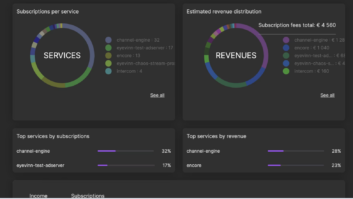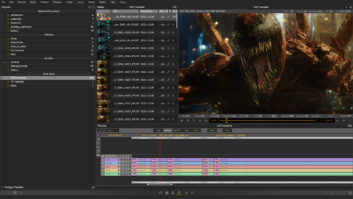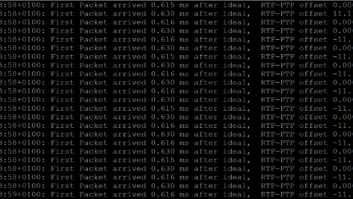Open source software is an invisible foundation of the modern world. Coined in 1998, the term refers to any software for which the source code is made available to anyone to use under licence. Many operating systems are open source and in the media space, open source programmes like FFmpeg, GStreamer and VLC are widely used by end users as well as under the hood of commercial products. These examples have wide applicability to many industries, but we are fortunate to have a wealth of broadcast-focused open source projects that, although very niche, are used by broadcasters, streaming providers and vendors alike. In a sea of paid-for software, why do companies release their code for free?
Eyevinn Technology is a Swedish independent video streaming consultancy that makes many of its test tools available on its open source repository on GitHub. “We believe that the greater benefit for the industry is to push new technology and make it easier to adopt,” explains Jonas Birmé, VP of research and development. “When we are solving a problem for a client, it’s often easier to have a dedicated test tool or software component. If we develop that, why should others have to invent the wheel?”
The company’s most popular open source software is the VOD2Live engine which creates a linear channel from pre-encoded VoD assets. “From a proof of concept in 2018, we’ve seen very wide adoption in a production,” adds Birmé, who points out another reason for using open source. “We’ve been approached to develop features for VOD2Live. Everyone’s welcome to contribute to the projects, but part of our business model is to accept paid development to extend a project. Afterwards, we contribute the new code back to the repository for everyone to use.” Eyevinn Technology’s software can be found at https://github.com/Eyevinn and includes a multiviewer, a proxy to introduce errors to HTTP streams to test players, a test ad server, and a transport stream generator among many others.
MediaInfo is a well-known tool for reading detailed metadata in most media files and has been around for over 20 years. Widely used to get technical details about A/V files and built into asset management workflows, MediaInfo is an open source project from MediaArea. “We want customers to choose us because they trust us and value our skills,” states Jérôme Martinez, digital media analysis specialist at MediaArea. The company also maintains DVRescue which repairs errors in transfers from DV tapes, conformance engine MediaConch and a BWF Metadata editor, all of which were developed for companies who sponsored the development. Martinez continues: “With open source, we don’t hold the keys to the software so customers can use our skills or develop on their own. For a lot of open source developers, open source software is a goal, but for us it is a means.”
The IP showcase saw its debut at IBC 2016. Even while the SMPTE ST 2110 suite of standards was still being drafted, the showcase demonstrated how uncompressed IP can work as well as vendor interoperability. The Video Services Foundation (VSF) first undertook collaborative work describing how to deliver ‘SDI’ as IP in specifications which later fed into the SMPTE standardisation process. ST 2110 is still being extended and has been the result of work from the global broadcast community. The European Broadcast Union was one such contributor and even before 2016 was taking a strong interest in the work. Willem Vermost is the product owner for the EBU Live IP Software Toolkit, also known as LIST, available on the EBU’s open source GitHub repository. “Before ST 2110 was a document, we felt it only made sense that the move to IP should be hand-in-hand with a move to software,” he explains. “But we knew burstiness of IP packets would be much harder without hardware.”
Since its humble beginnings as an excel spreadsheet, LIST has become a live test and measurement tool for timing compliance for ST 2110 and even has an online version which analyses uploaded packet captures. But Vermost explains the tool caused a problem. “It was important for the EBU to stay neutral in its efforts to contribute to ST 2110 and also in our role to bring people together.” Off the back of the first IP Showcase, a regular formal test event, called JT-NM, was devised which would test vendor interoperability. “We used LIST as a tool to get the test and measurement companies together and being open source was a critical part of the strategy. Once this was open source, we were no longer competing with any products and, importantly, we were then able to add definitions to the project,” he adds. As new software came on the market, each product labelled and calculated things differently. “The LIST project became a place to document the formulae and descriptions for common measurements. This collective knowledge will soon be included in the 2110 suite as SMPTE RP 2110-25.”
Part of the benefit of ST 2110 is the separate carriage of the essences needed for uncompressed live production. To control all these media flows, a group of specifications called Networked Media Open Specifications (NMOS) has been developed by the Advanced Media Workflow Association (AMWA) who describe NMOS as “open, industry developed, free of charge and available to everyone”. It’s no surprise, then, that the automated NMOS API Testing Tool is available on AMWA’s GitHub repository but Peter Brightwell, lead R&D engineer at BBC Research & Development, explains that the reasoning is deeper.
“We made some of the BBC’s early NMOS implementations open source to seed community interest,” Brightwell starts. “For a control-plane API such as NMOS, interoperability testing is essential so we started holding regular interoperability workshops.” As more vendors came on board, so the interoperability workshops grew. In fact, the latest interoperability workshop saw 17,000 tests on over 70 devices which is only practical with automation.
Brightwell continues, “Developing the NMOS specifications came to require a large amount of regular manual testing. To remove this and to speed up our interoperability workshops, the automated API Testing Tool was born.” Easy to deploy and controllable by a locally-generated web interface, the ever-growing suite of NMOS specifications such as IS-04, IS-05 can be quickly tested. Brightwell concludes, “By open-sourcing the tool, vendors can see exactly how the tests work and what’s more, seeing the code for an NMOS specification can make understanding and implementing NMOS in your own product much quicker.”
A common theme in media and broadcast has been collaboration within the industry using the principle that a rising tide floats all boats. From the standardisation of film that created SMPTE, to the resounding success of SDI and more recently low-latency streaming with CMAF, collaboration has been vital. The projects discussed here show that not only can open source be part of a business model but that it’s a powerful tool to bring today’s best and brightest to the conversation, to build the future and to help broadcasters and vendors alike swiftly adopt new technology.






